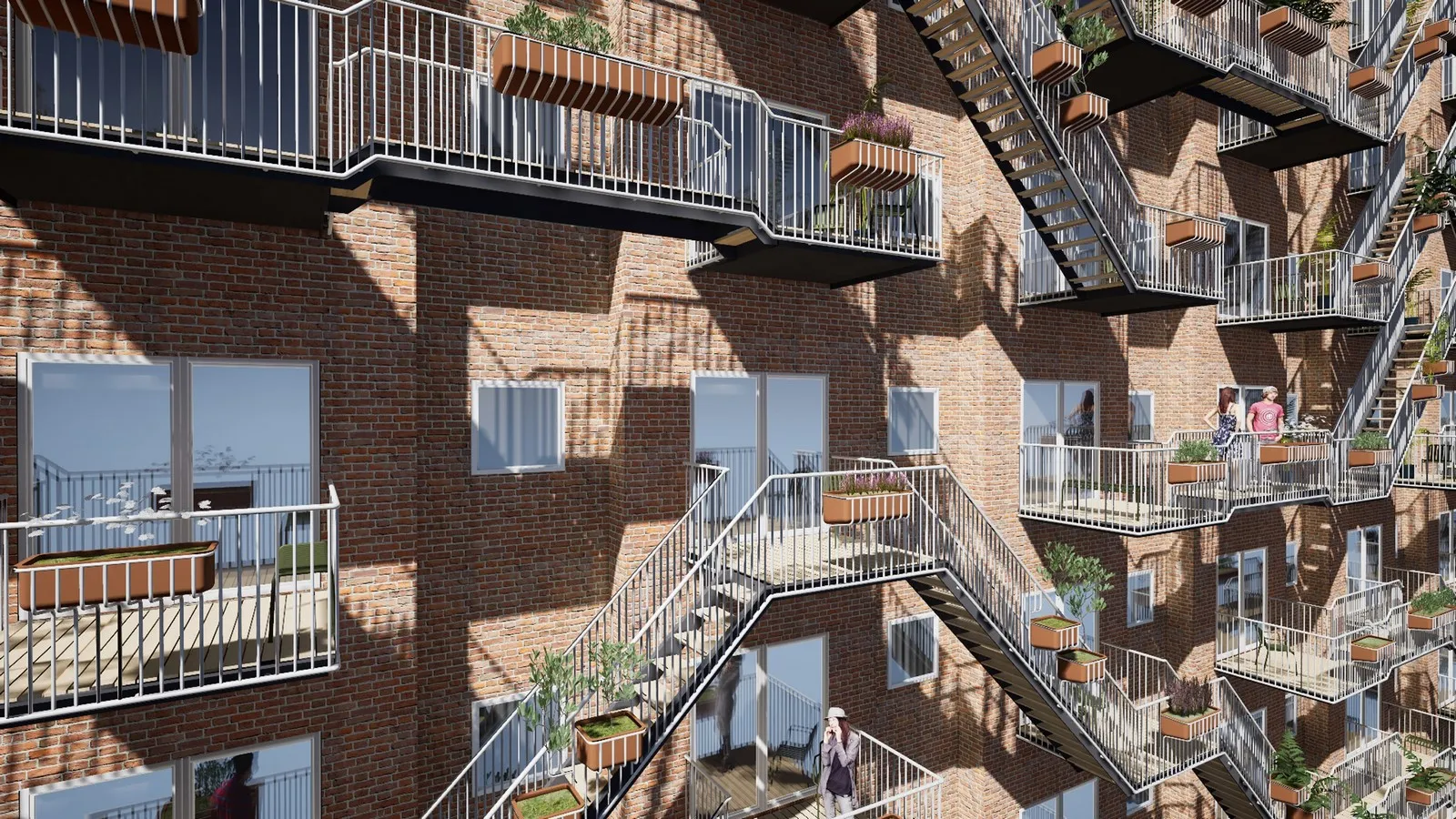Imagine stepping out from your living room onto a balcony suspended in mid-air, a private sanctuary bathed in sunlight or twinkling with city lights. Hanging balconies, in their many forms, offer a unique blend of functionality and aesthetics, transforming outdoor spaces into breathtaking retreats. This guide delves into the captivating world of hanging balconies, uncovering the secrets of their design, engineering, and construction, empowering you to bring your own suspended oasis to life.
Hanging Balcony Details: Your Guide to Effortless Outdoor Living
A hanging balcony provides a seamless transition between indoor comfort and outdoor beauty. But how do these structures seemingly defy gravity while providing a safe and inviting space? Let’s explore the key elements that make hanging balconies possible:
How do they Stay Up There? Exploring Support Systems
Behind the effortless elegance of a hanging balcony lies a carefully engineered support system. Here’s how these balconies achieve their gravity-defying feats:
- Cantilevered Balconies: Just like a diving board extending out from its base, a cantilevered balcony projects outward from the building without any visible supports. This design, ideal for smaller balconies, creates a modern, minimalist aesthetic.
- Galvanized Steel Cables: For larger balconies, especially those on higher floors, galvanized steel cables offer unparalleled strength and stability. These cables are securely anchored to the building’s structural framework, ensuring the balcony can handle significant weight loads.
- Gallows Brackets with Tie-Rods: If a hidden support system aligns with your design vision, gallows brackets with tie-rods offer a discreet yet powerful solution. Triangular brackets, known as gallows brackets, are fixed to the building wall. Tie-rods then connect the balcony platform to these brackets, effectively transferring the weight while remaining largely concealed.
Putting it Together: Construction Insights
Building a hanging balcony is a meticulously planned process, with steel often being the material of choice due to its strength, durability, and resistance to the elements. The construction process involves assembling brackets, rods, and the balcony platform, securely attaching them to the building’s structure. Precision is paramount during installation to ensure the balcony’s long-term safety and stability.
Weathering the Storm: Waterproofing Wisdom
Exposed to the elements, a hanging balcony requires proper waterproofing to prevent damage from rain and moisture. The following methods provide effective protection:
- Exposed Membrane Waterproofing: This method places a visible waterproofing layer directly on the balcony’s surface. Think of it as a durable raincoat for your balcony, easy to inspect and maintain.
- Protected Membrane Waterproofing: In this method, the waterproofing layer is concealed beneath the balcony’s surface, providing an invisible shield against moisture. Protected membrane waterproofing generally requires less upkeep and boasts a longer lifespan.
Designing Your Dream: Factors to Consider
While safety and structural integrity are paramount, the design of your hanging balcony should also reflect your aesthetic preferences and intended use. Consider these design factors:
- Size and Placement: Will your balcony be a cozy haven for morning coffee or an expansive outdoor dining area? Determine the balcony’s purpose, desired size, and how it will integrate with your indoor living space.
- Height Matters: A higher balcony might offer breathtaking views but necessitates careful consideration of engineering, railing systems, and even local building codes to ensure safety and security.
Bringing it Home: Your Balcony Awaits
Hanging balconies hold the power to transform houses into homes, adding a touch of magic and expanding living spaces. By understanding the fundamentals of design, construction, and the crucial role of waterproofing, you can create an outdoor haven that’s as beautiful as it is enduring. Dream big, and let the planning of your perfect hanging balcony begin!
What are the different types of hanging balcony designs?
The world of hanging balconies extends beyond the purely functional, offering a range of styles to complement any architectural aesthetic. Let’s explore some popular designs:
Juliet Balconies
Evoking images of romantic evenings and timeless elegance, Juliet balconies, with their intricate wrought-iron railings, add old-world charm to historic and modern buildings alike. Don’t let their delicate appearance fool you; Juliet balconies are expertly crafted for both beauty and structural integrity.
Cantilevered Balconies
For those who appreciate modern architecture and minimalist design, cantilevered balconies present a striking visual statement. These balconies appear to magically extend outwards, seemingly defying gravity with their hidden support beams. Cantilevered balconies are ideal for maximizing space where visible support structures are not desired.
Suspended Balconies
If panoramic views and a sense of floating above the landscape spark your imagination, suspended balconies offer the ultimate sky-high experience. These balconies hang from a secure overhead structure, providing unobstructed views and a feeling of unparalleled openness.
To sum it up:
- Hanging balconies add distinct character and valuable outdoor living space to any building.
- Juliet balconies offer timeless elegance and intricate designs.
- Cantilevered balconies embrace a modern aesthetic and maximize space with their concealed support systems.
- Suspended balconies provide breathtaking, unobstructed views and an exhilarating floating sensation.
Want to explore even more fascinating balcony styles? Check out Architectural Styles: A Visual Guide!
How much does a hanging balcony cost to build?
As you envision yourself relaxing on your future hanging balcony, it’s essential to consider the financial investment involved. While determining the exact cost requires a personalized assessment, understanding the key factors that influence pricing will help you plan accordingly.
Several variables impact the final cost of a hanging balcony, making it difficult to provide a one-size-fits-all estimate. A small, simple balcony using budget-friendly materials could cost a few thousand dollars, while a larger, more elaborate balcony constructed with premium materials could reach $10,000 or more.
Here’s a breakdown of the primary factors influencing cost:
- Size Matters: Larger balconies require more materials and labor, directly impacting the overall cost.
- Material Selection: The choice of materials significantly influences the budget.
- Wood Composite: Offering a classic wood aesthetic, wood composite tends to be pricier than other options.
- Vinyl: A budget-friendly and durable alternative, vinyl requires minimal maintenance.
- Steel: Known for its strength and longevity, steel comes at a higher price point, typically ranging from $80 to $120 per square foot.
- PVC: Striking a balance between affordability and durability, PVC balconies cost approximately $40 to $95 per square foot.
Keep in Mind: These figures provide a general estimate. For a precise cost breakdown, consult with a local contractor who can assess your specific project requirements, location, and any unique site conditions.
Key Takeaways:
- Building a hanging balcony is an investment ranging from around $2,000 to upwards of $10,000.
- Factors such as balcony size, materials used, and geographic location influence the overall cost.
Ready to take the next step? Contacting contractors in your area for personalized quotes is highly recommended. They can address your questions, provide accurate cost estimations, and guide you through the process. Happy building!
What are the best materials for hanging balcony construction?
Choosing the right materials is crucial for ensuring the safety, longevity, and aesthetic appeal of your hanging balcony. Here’s a breakdown of popular materials and their pros and cons:
Steel: The Strong, Silent Type
Steel is renowned for its strength, durability, and ability to withstand harsh weather conditions. Galvanized steel, coated to prevent rust and corrosion, is a popular choice for balconies, offering a sleek, modern look and requiring minimal maintenance.
Pros:
- Unmatched Strength and Durability: Steel handles heavy loads and extreme weather with ease.
- Rust and Corrosion Resistance: Galvanization ensures longevity and minimizes maintenance.
- Relatively Lightweight: Despite its robust nature, steel is surprisingly lightweight, simplifying installation.
Cons:
- Higher Price Point: Compared to other materials, steel typically comes at a higher cost.
Aluminum: The Lightweight Champ
If you’re seeking a lightweight yet robust material, aluminum is an excellent choice. Highly resistant to corrosion, aluminum is particularly well-suited for coastal environments. Its lightweight nature simplifies installation and often reduces labor costs.
Pros:
- Lightweight Design: Aluminum’s lightweight properties make installation a breeze.
- Exceptional Corrosion Resistance: Ideal for coastal regions, aluminum naturally resists corrosion.
- Impressive Strength: Don’t let its lightweight nature fool you; aluminum possesses impressive strength.
Cons:
- Cost Considerations: Aluminum, like steel, tends to be more expensive than other materials.
Wood: The Warm and Inviting Classic
Wood brings warmth, character, and a timeless appeal to any space. Customizable with various stains and paint colors, wood allows you to create a balcony that seamlessly blends with your home’s architectural style.
Pros:
- Unmatched Aesthetics: Wood exudes natural beauty, adding warmth and character to any outdoor space.
- Design Versatility: Staining and painting options allow for endless customization possibilities.
Cons:
- Maintenance Requirements: Wood requires regular upkeep, including sealing, staining, or painting, to prevent rot and decay.
- Susceptibility to the Elements: Compared to steel or aluminum, wood is more susceptible to damage from moisture, sunlight, and pests.
Making the Right Choice:
The “best” material for your hanging balcony depends on your individual needs, priorities, and budget. Steel and aluminum offer durability and low maintenance, while wood provides a classic aesthetic but requires more upkeep. Consulting with a qualified professional is essential to ensure your chosen material aligns with your desired design and meets local building codes.
No matter your choice, a well-built hanging balcony will provide years of enjoyment, extending your living space and connecting you with the outdoors.
Don’t Forget:
If you’re working with limited vertical space, a mezzanine floor plan design can be an ingenious solution. For a 14′ ceiling height, a 48″ high mezzanine 114 pol effectively doubles your usable square footage. Alternatively, a mezzanine 4’ in height provides a comfortable 6’8″ of clear height underneath.
- Dark Backsplash Ideas: Drama and Depth for Your Kitchen - November 7, 2025
- Black Backsplash Tile: Find The Perfect Style For Your Kitchen - November 6, 2025
- Black Backsplash With White Cabinets: A Bold Kitchen Design - November 5, 2025










